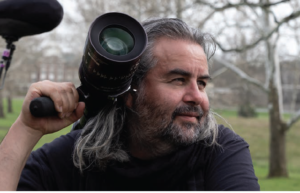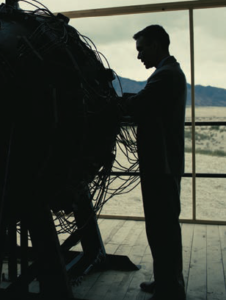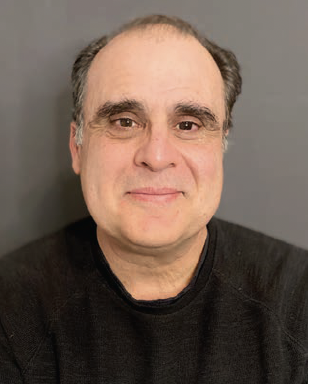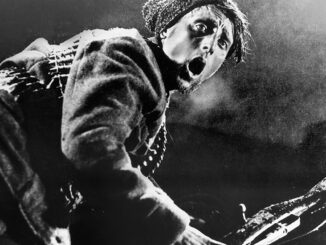
By Jennifer Walden
It wasn’t quite as daunting as building the first a tomic bomb, but putting together “Oppenheimer” was still no easy feat.
“It’s always helpful to get one under your belt with a director, to learn their approach to filmmaking,” Lame said, “Chris [Nolan] does it a little bit differently with regard to the film workflow, the dailies workflow, and the finishing film workflow. So getting to know him and his process was helpful. This second time around, we already had that familiarity, that shorthand, which made it easier.”
Easier, perhaps – but the process still presented plenty of challenges. “We’re introducing a lot in the first 20 minutes: setting up [both] black-and-white and the color [film stocks], setting up who Oppenheimer is personally and his relationship with Strauss [a rival played by Robert Downey Jr.], setting up Room 2022, and setting up his scientific life,” she said. “I just wanted to nail that first 20 minutes in a way that would let the audience settle in and get to know this person, yet not feel bored. I was constantly aware of that pacing. You have to keep up the momentum, but not make it feel rushed, and that’s hard to achieve with a three-hour movie,” she said.
And then there were the technical challenges, which presented some Ph.D.-level puzzles to solve.
Filmgoers who saw “Oppenheimer” in theaters this summer had numerous viewing options, from analog film formats including IMAX 70mm, 70mm, and 35mm to digital options like IMAX digital, Dolby Cinema, and standard 4K digital cinema. Nolan is known for shooting on large-format film stock, so for him, the IMAX 70mm presentation provided the ideal cinema experience as it most closely represented how the film was originally captured.
Working with film took Lame back to the dawn of her career. Lame noted that most editors her age and younger have worked only in the digital world, so the film workflow may not be familiar to them. “My first job was working on a film movie, ‘Before the Devil Knows You’re Dead.’ That was shot on film, the dailies were screened on film – everything. I feel lucky to have had that early opportunity to work with film.”

Nolan tapped long-time collaborator DP Hoyte Van Hoytema, ASC (member of ICG Local 600), who lensed “Tenet,” “Dunkirk,” and “Interstellar.” He and Hoytema chose to shoot “Oppenheimer” on IMAX 65mm (15-perf) and 65mm (5-perf) using Kodak Vision3 250D 5207 film, Kodak Vision3 500T 5219 film, and a specially created IMAX 65mm black-and-white (B/W) film stock named Eastman Double-X 5222.
The black and white IMAX stock didn’t exist before this film. Nolan wanted to shoot the scenes with Strauss in black and white as this represented Strauss’s either/or, “black and white” perspective. The color stock is used for Oppenheimer’s perspective. Since there are two time periods intercut throughout the film — the making/testing of the bomb (color) and the security hearings (b/w) – the idea was that the use of color and b/w helped to make that clearer for the audience.

crews to get familiar with film workflow. UNIVERSAL PICTURES
Creating a new type of film stock for “Oppenheimer” posed a few challenges. Hoytema said, “First, we had to ask Kodak if they could manufacture IMAX 65mm B/W film. Since it was never done before, they had to investigate if they could manufacture it. From the beginning, there were many engineering challenges. One was the thickness of the backing on the film stock, and the chemical makeup of the emulsion. It’s all very different. Theoretically, you can put emulsion over a strip of plastic but how does that work for the rolls, and in the camera, and how it’s developed at the lab? Those are aspects to consider.”
Several rounds of testing were necessary to achieve the desired result. Initial problems were the amount of dirt and scratches on the film as well as strange light arc effects due to the thickness of the backing. “We had to re-engineer the cameras a little bit – redo pressure plates in the cameras in order to omit reflecting issues,” said Hoytema, who shot “Oppenheimer” with both IMAX cameras and the Panavision System 65 Camera.
Additionally, the team had to convince the lab, FotoKem, to accommodate their processing needs for the new film stock. “They had to install gigantic tanks at their facility so they could switch between chemicals to develop the color IMAX film and chemicals to develop the IMAX B/W film,” explained Hoytema. “At every stage along the way – from the manufacturer to the rental house to the camera technicians to the lab – everybody was engineering to try to make it work. But the first time we saw a test projected, we knew that this was going to be it. We knew exactly what we had to do to fix certain problems to make it a valid shooting medium. Once we decided this in our minds, we knew we had to convince the lab to do it because it was a huge operation for them as well.”

FotoKem provided film processing, duplication, and telecine. They liaised with additional editor Michael Fay – brought on to the film by Lame, who happened to be editing “Black Panther: Wakanda Forever” during the production of “Oppenheimer.” Fay helped coordinate the processing schedule with the lab because switching from 65mm color to 65mm B/W took three days. “Processing 65mm B/W negative uses completely different chemicals than those used for color processing. So FotoKem had to devise a method to drain all the color chemicals, clean the processors out, and then reload them with the appropriate B/W chemicals. We got that down to about two days towards the end of the schedule,” he said.

Coordinating this changeover – to minimize downtime and allow the team to screen the footage sooner – was one of Fay’s many tasks on the film. As was orchestrating the transportation of the film to the lab and back to set, which typically took two days depending on the distance between the shooting location and the lab in Los Angeles. For instance, when shooting in New Mexico, production would do a film break at 7 p.m. The transportation department had a team of drivers who would drive the film back to L.A., breaking up the 13-hour journey into manageable chunks for each driver. The next morning, the film would arrive at FotoKem and be processed. Prints would be struck and sent that afternoon to the Los Angeles-based editorial team for QC who would report back any technical issues to the team on set. The L.A. film editorial team, led by 1st Assistant Editor, Tom Foligno, would then break the printed takes down into daily rolls, prep them for telecine, and hand them off to drivers that same night. The drivers would bring the prints back to New Mexico in time for the dailies screening the following afternoon. “We screened dailies every day, watching our dailies from two days prior,” Fay said, “Chris [Nolan] really believes in screening dailies as a company every day.”
A dailies trailer was set up on location and outfitted with projectors capable of playing 70mm and 35mm prints. “We screen a 35mm reduction print of our IMAX dailies because there are just no IMAX projectors small enough to fit into a trailer, but we were able to watch the dailies of the 5-perf 70mm footage,” explained Fay.

Since the production schedules were based on location and actor availability, sometimes the footage shot in 65mm B/W – such as the scenes with Robert Downey Jr.’s character Lewis Strauss – would be held for days, or even weeks, before it was processed at the lab. Fay noted, “This was mostly an issue at the end of the shoot when we, by necessity, needed to do a couple of shots in B/W on this day, a couple of shots in B/W three days later, and another day’s worth of B/W a week later. We would hold all that footage until we amassed enough material that it made sense for us to convert the lab to B/W. Since we were shooting so much color, we didn’t want to slow down the color processing because that was the bulk of the material. But it was a little tense while we waited to see those B/W dailies we shot weeks ago. Was there a scratch? Was there some other issue that we would only be aware of once we got to see that footage? The wait was a little tense.”
In addition to large-format film stock, several shots were captured on 35mm color film on an ARRI 435ES. According to Fay, these were primarily VFX shots on which they wanted to have a very slow-mo effect. He explained, “We were looking to shoot 150 FPS, which the IMAX camera couldn’t do. The fastest it will shoot is 48 FPS, but we wanted a slower look than that.”
As mentioned, FotoKem telecined the dailies, creating HD 1080p 24fps MXF files for the Avid workflow. During production, 1st Assistant Editor, Nick Ellsberg, and the L.A. editorial team started the process of syncing them, organizing them, and prepping them for the editor Lame.
All the telecined assets from FotoKem contained key code information from the physical film, preserved in the master clips as metadata. These numbers correspond to the physical negatives, so all the cuts that Lame made in the Avid could be matched back to the original film. Before picture lock, the team held several screenings on film, including the 10-week Director’s Cut screening and Friends and Family screenings. Once Lame locked picture for a screening, Avid’s list tool was used to generate an assemble list (cut list). This list was given to the film team, who used it to conform the workprint to match Lame’s cut. According to Fay, “The workprint conform started about four weeks into the director’s cut. Chris screens his director’s cut on film, and that’s a 70mm (5-perf) screening, so it was a mad dash to get everything ready.”
‘Waiting for the dailies got a little tense.’
Avid’s list tool was also useful for generating a cut list for the 65mm (5-perf) negative, but the footage shot on IMAX film required a different approach. Fay turned to VFX editor Ed Marsh, who designed a custom database tool to generate a “minus list” for the IMAX footage. Fay explained, “Basically, IMAX doesn’t use traditional Avid-generated cut lists. They prefer a different kind of list called a ‘minus list.’ These lists transform a traditional cut list by taking each key number and rounding the feet+frames up to the next whole zero frame, and then counting backward to the frame requested. This approach allows IMAX to visually confirm the requested key number on the work print and negative before cutting. Ed’s custom database tool automated this step and generated the minus lists for IMAX. The IMAX negative cutter used that minus list in conjunction with the 35mm workprint to check for accu-racy before cutting the negative.”
So, once the locked cut was approved, the final cut lists were given to the film team to conform the workprint. Once this matched the locked cut, they would give the conformed workprint and a negative cut list to the negative cutters. Fay said, “We did two of these. We did a 5-perf 65mm negative cut and then we did a 15-perf IMAX negative cut. Both of those require different workprints and different sets of lists to go to the respective negative cutters.”
Cutting the actual negative is a very purposeful and very manual task, noted Fay. It is not something that can be automated. “We want someone – a human with a brain – who is considering every cut and making sure that the cut they are going to make is exactly correct, that it has been confirmed on the workprint, and has been confirmed on the cut list, so all of their information is correct, and it’s all matching.”
If there was a discrepancy, which could potentially happen, the negative cutter would catch it before a cut was made, and inform the editors. They would investigate it, correct it, and issue a new list. “Having a negative cutter who is very methodical and very careful is a really important part of the process,” said Fay. “For ‘Oppenheimer,’ we had negative cutter Simone Appleby, who cut ‘Dunkirk’ as well. It was so reassuring to have someone so methodical and diligent with their work, to report back if there were any questions, and to make sure that what they were doing was exactly correct. There were 3,300 cuts in the whole movie. Every single one of those is carefully considered, and carefully cross-checked, and then needs to be executed. Ultimately, Simone was joined by additional negative cutter, James Manke, who came on to help finish the negative cut. With so many cuts, it took a bit longer to do (a little over three months). The two of them are amazing.”
For all the challenges, the finished prod-uct is in many ways a tribute to the medium of film, in all its old-fashioned grandeur.
In fact, Hoytema is seeing a renewed interest in film with his students. He said, “When I give master classes, students are always in awe of the medium. They think that you need very specific precision and you need to follow a lot of rules. But, even if you’re a little bit rough with your light readings, the chance that you end up with an image that is interesting or inviting is pretty high. I always encourage people to just do it; don’t be afraid of it and drive it like you stole it. Don’t be too precious. You’ll very quickly see an interesting result or something that is useful – something that can capture a little bit of the soul of what you’re observing in real life. It’s easier than you think.”
Lame added: “It’s difficult to find people who can learn the film workflow quickly since it isn’t taught anymore, which is sad. What’s nice, though, is there’s always a correlation between the digital workflow and film workflow, since the digital is based on the film world. So when you explain the film world to someone who hasn’t had the experience, they can start to understand it pretty quickly when they think about the digital workflow.”
Jennifer Walden is a freelance writer specializing in post-production technology.





